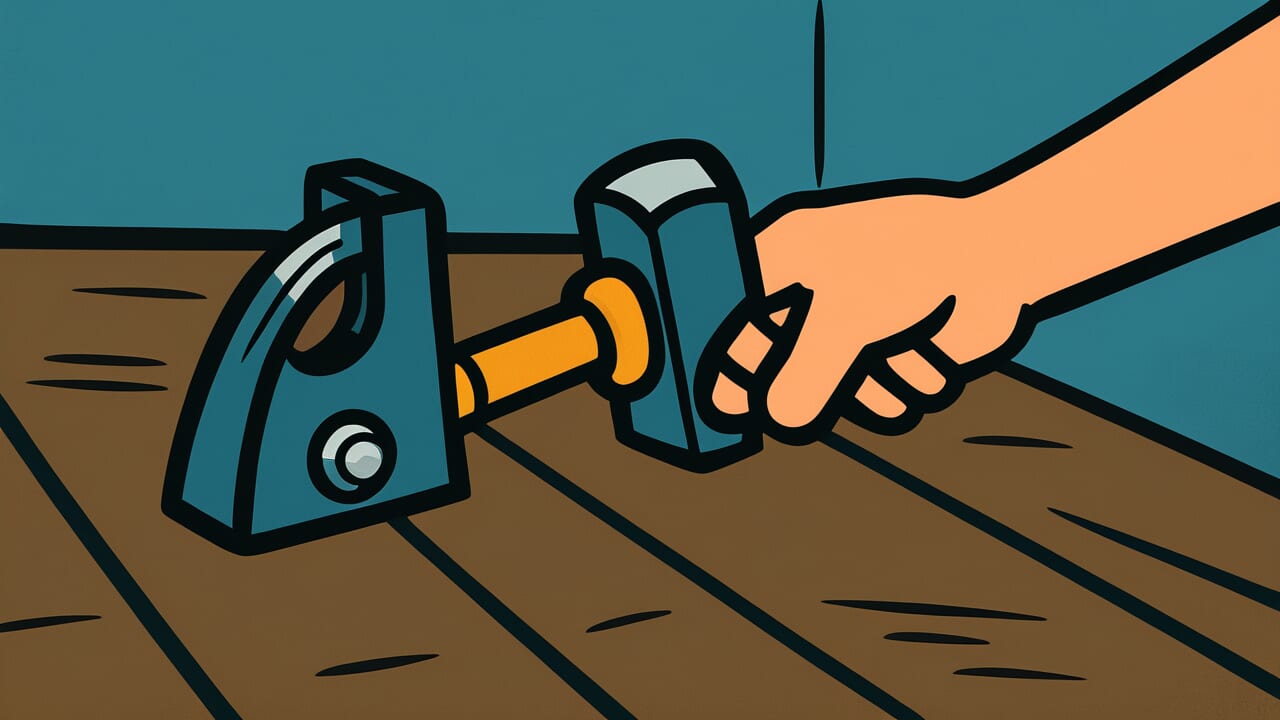How to Read “Straighten a bent nail with a hammer”
Kugi no magari wa tettsui de naose
Meaning of “Straighten a bent nail with a hammer”
This proverb teaches that just as you can straighten a bent nail by striking it with a hammer, people can be guided back to the right path through proper training and guidance.
It’s mainly used in education and personal development contexts. The saying is used with hope when dealing with people who have developed bad habits or strayed from the right path.
It expresses the belief that strict guidance can help them reform. It can also be used positively when working on your own flaws, meaning that effort and training can bring improvement.
This expression is persuasive because it’s based on physical fact. A bent nail really can be straightened with force.
This concrete truth supports our belief in human potential for change.
Today, as the value of strict guidance and training is being reconsidered, this proverb is understood to mean “people grow when given appropriate challenges.”
Origin and Etymology
The exact first appearance of this proverb in literature is unclear. However, based on its structure, it likely combines blacksmith techniques with human education.
Nails have long been essential tools in construction and woodworking. They’re made by heating and hammering iron into shape.
But nails often bend during use. A bent nail can be straightened again by striking it with a hammer.
This simple fact became a metaphor for human growth and education.
What’s interesting is that this proverb focuses on the act of “striking.” During the Edo period, a similar saying “Strike iron while it’s hot” was widely used.
But that one emphasizes education while young. “Straighten a bent nail with a hammer” talks about correction after something has already gone wrong.
In other words, it contains a more hopeful message. Even after people stray or develop bad habits, proper guidance and training can bring them back to the right path.
This expression shows how practical wisdom from the blacksmith’s workshop was elevated into a truth about human education.
Usage Examples
- My son’s behavior has gotten worse, but “straighten a bent nail with a hammer” means it’s not too late
- Even if new employees have attitude problems, let’s guide them patiently with the spirit of “straighten a bent nail with a hammer”
Universal Wisdom
The deepest truth this proverb speaks is trust in human potential for change. Even something that has bent can be restored with the right force.
Within this simple physical law lies hope for humanity.
Everyone makes mistakes. People stray from the path and fall into bad habits.
When this happens, people around them show two reactions. One is to give up, saying “it’s too late.” The other is to believe “it can still be fixed.”
This proverb clearly takes the latter position.
What’s interesting is that the proverb doesn’t say things “fix themselves naturally.” A hammer is needed.
In other words, for people to change, external intervention is essential. Sometimes strict guidance and training are necessary.
It shows the harsh reality that gentle watching alone is not enough. Appropriate pressure is required.
However, this proverb doesn’t justify violence or excessive force. You strike a nail with a hammer not to destroy it, but to restore its original shape.
Training people isn’t about crushing them either. It’s about bringing out the goodness they naturally possess.
This delicate sense of balance reveals the depth of our ancestors’ wisdom.
When AI Hears This
When you bend a nail, the crystal structure inside the metal deforms and defects called “dislocations” increase.
More dislocations make metal harder but also more brittle. This is called work hardening.
A bent nail is harder than before bending, and more likely to break.
When you try to straighten it by hammering, dislocations increase further and work hardening progresses.
With aluminum, hammering at room temperature doubles its hardness, but reduces elongation by more than half.
The same happens with nails. The more you hammer, the harder and more brittle they become, until they suddenly snap.
Trying to solve a problem using the same method that caused it makes things worse.
In materials science, there’s a way to restore hardened metal. It’s called annealing.
When you heat metal appropriately, the disrupted crystal structure rearranges and dislocations decrease.
For iron, heating to 500-700 degrees and cooling slowly restores original flexibility.
Not the forceful approach of hammering, but the opposite approach of warming and resting.
This principle shows the essence of problem-solving. Repeating the same method breaks the internal structure beyond its limit.
Sometimes a completely different, even opposite intervention is needed.
Lessons for Today
What this proverb teaches modern people is the courage to keep believing in human potential.
In today’s world, we tend to give up quickly when results don’t come fast. But people need time to change.
And change requires appropriate intervention.
If you’re in a position to guide others, don’t quickly write someone off when you see their flaws or failures.
With proper guidance and patient involvement, people can always grow.
However, this shouldn’t mean rejecting the person. It should be intervention to bring out their natural goodness.
And this proverb is also directed at you personally. When you notice your own bad habits or weaknesses, you don’t need to give up thinking “I can’t change anymore.”
With proper effort and training, you can definitely change.
What matters is the will to change and concrete actions to make it happen.
People can start over at any age, from any condition. This proverb delivers that message of hope to you.



Comments